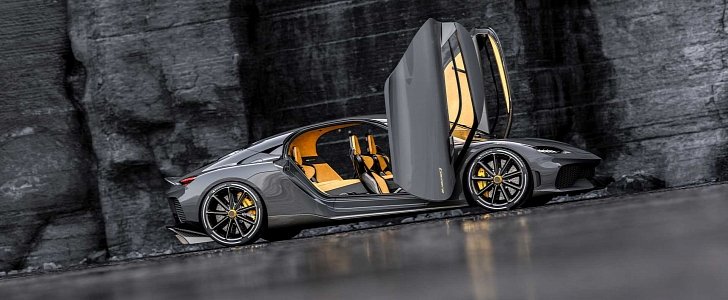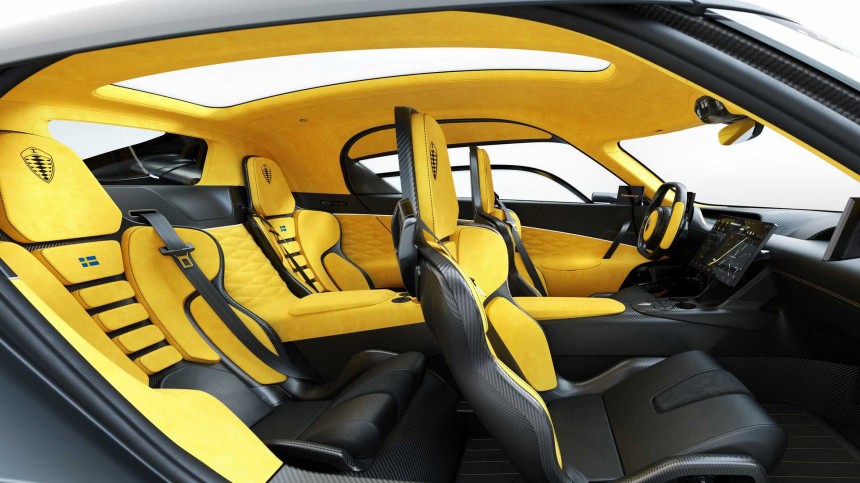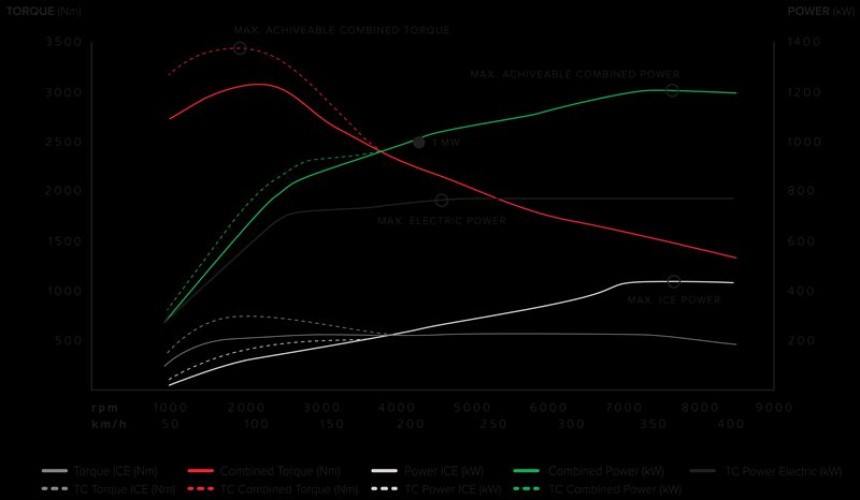In the ever-more-exciting rivalry between Bugatti and Koenigsegg (brands listed here in alphabetical order) the latter has just won a massive battle and it was all done by... actually showing up to the fight. You see, while Molsheim never delivered a production version of the 16C Galibier front-engined four-door concept released back in 2009, Koenigsegg used a different path - there was no concept, but here we are, bewildered by the introduction of the for-four Gemera.
Not sharing the Geneva floor with the Jesko Absolute top speed monster that we'll discuss later today (the 90th edition of the Swiss event was canceled due to Coronavirus-related risks), this Mega-GT, as its maker describes it, may pack two less doors than the said Volkswagen Group concept, but its doors are long enough to allow four adults to slide in.
Oh, and these open upwards thanks to something called Koenigsegg Automated Twisted Synchrohelix Actuation Doors. And, thanks to an extremely strong carbon fiber monocoque, there's no need for B-pillars.
In case you're wondering, the wheelbase sits at 3,000 mm/118.11 inches, which places it just above that of the Porsche Panamera, for instance.
As you've figured out by now, this is one for the family, with the list of coziness features involving goodies such as cold and warm cupholders, ISOFIX child seat latching points in the back, infotainment displays up front and in the back, memory foam heated seats, three climate zones, and many others. Interestingly, only the front seats are power-adjustable.
The occupants will be kept safe thanks to features ranging from all-wheel steering, AWD and all-wheel torque vectoring to advances electronic assistance systems and six "smart" airbags, among others.
As the Egg fans among you have probably noticed, the front end styling is a nod to CC, the Koenigsegg model that started it all back in 1996 - for the record, this was also the model used by kickstart the Koenigsegg Sketch Challenge, a social media stunt that saw former Bugatti designer Sasha Selipanov, who now serves the Swedish carmaker, inviting artists from all over the world to share their vision of the extreme-velocity brand.
Speaking of which, this was a project Selipanov completed from the ground up - you'll find find the design sketch at the bottom of the page.
This is a K machine, so you're all expecting jaw-dropping numbers. Well, here you go: 1.27 MW (1,727 PS) and 3,500 Nm, a 0 to 100 kph/62 mph time of 1.9 seconds a nicely rounded top speed of 400 kph/248 mph.
And, if you've paid attention to the Regera hypercar-gone-GT, the source of all the muscle won't surprise you: we're talking about a hybrid setup. However, unlike in the case of the Regera, where the company's twin-turbo V8 dominates the gym, the Gemera's powertrain only packs a 2.0-liter three-cylinder motor.
Dubbed a Tiny Friendly Giant (wait for it), the unit makes use of two turbos, while employing the company's trademark Freevalve technology (think: no cams), which the carmaker has been improving for years. As a result, it delivers 608 PS and 600 Nm of torque to the front axle. Koenigsegg even invites owners to bring the tank with second-generation ethanol of the CO2-neutral methanol, while your standard E85 will also do. The good old dinosaur juice? Here's what the press release says: "in worst case normal petrol".
The rest of the powaaah comes from three electric motors (one for each rear wheel and one attached to the crankshaft). Their combined output of 800 kW/1,115 PS can push the car to 300 kph/186 mph without needing to wake up that tiny giant. We're talking about a 16.6 kWh battery and this is 800V hardware, which ensures a quick charge - we are told that the Gemera can deliver an electric range of up to 50 km/36 miles.
And while the front axle features a hydraulic coupling, the kind we've met on the no-gearbox Regera, each of the rear electric motors come with a single-speed transmission that can be decoupled using a wet clutch, for when extra power must be traded in for a range boost.
On the practicality front, the 117mm ground clearance is respectable (not that Koenigsegg hypercar owners were ever stopped by the low-riding nature of their machines), albeit with the combined luggage capacity of the front and rear storage compartment being limited to 200 liters - this is probably why Koenigsegg offers a roof box as a factory option (did anybody recruit Jon Olsson on the team?)
What does the four-seater layout mean as far as the scale footprint is concerned? Well, in an apple-to-orange comparo, I'll mention that the Gemera weighs in at 1,715 kg dry (curb weight: 1,850 kg), while the Regera sits at 1,420 kg (curb weight: 1,628 kg) and the Jesko at 1,320 kg (curb weight: 1,320 kg).
While Bugatti has recently showcased a trio of canceled concepts and continues to introduce Chiron derivatives and editions, the French carmaker is still expected to introduce a second model this decade. So let's see how the battle between the two brands carries on.
Meanwhile, if we return to the Koenigsegg Sketch Challenge, we've seen the company's DNA being stretched in pretty much every imaginable form, from a Le Mans Hypercar entry to an SUV. And, despite those being "unofficial renderings that remain the property of their designers", it looks like Koenigsegg won't close the range expansion door too soon.
Koenigsegg is only building 300 units of the Gemera, with this being a new record for the automaker. The price tag hasn't been announced (you could expect it to sit anywhere between $1 and $2 million). Nevertheless, if we look back at how quickly the 125 build slots of the Jesko found their people, it looks like those in the market for such a land rocket might want to hurry, especially since it will also be available in the States.
Update:While talking to Top Gear, Christian von Koenigsegg let it slip that the price of the Gemera kicks off at $1.7 million. To put that into context, we have to keep in mind that the Jesko, the Gemera's current stablemate, comes with a $2.8 million sticker. As for the direct competitors of the four-seater hypercar... wait, it does't have any...
Oh, and these open upwards thanks to something called Koenigsegg Automated Twisted Synchrohelix Actuation Doors. And, thanks to an extremely strong carbon fiber monocoque, there's no need for B-pillars.
In case you're wondering, the wheelbase sits at 3,000 mm/118.11 inches, which places it just above that of the Porsche Panamera, for instance.
As you've figured out by now, this is one for the family, with the list of coziness features involving goodies such as cold and warm cupholders, ISOFIX child seat latching points in the back, infotainment displays up front and in the back, memory foam heated seats, three climate zones, and many others. Interestingly, only the front seats are power-adjustable.
The occupants will be kept safe thanks to features ranging from all-wheel steering, AWD and all-wheel torque vectoring to advances electronic assistance systems and six "smart" airbags, among others.
Speaking of which, this was a project Selipanov completed from the ground up - you'll find find the design sketch at the bottom of the page.
This is a K machine, so you're all expecting jaw-dropping numbers. Well, here you go: 1.27 MW (1,727 PS) and 3,500 Nm, a 0 to 100 kph/62 mph time of 1.9 seconds a nicely rounded top speed of 400 kph/248 mph.
And, if you've paid attention to the Regera hypercar-gone-GT, the source of all the muscle won't surprise you: we're talking about a hybrid setup. However, unlike in the case of the Regera, where the company's twin-turbo V8 dominates the gym, the Gemera's powertrain only packs a 2.0-liter three-cylinder motor.
Dubbed a Tiny Friendly Giant (wait for it), the unit makes use of two turbos, while employing the company's trademark Freevalve technology (think: no cams), which the carmaker has been improving for years. As a result, it delivers 608 PS and 600 Nm of torque to the front axle. Koenigsegg even invites owners to bring the tank with second-generation ethanol of the CO2-neutral methanol, while your standard E85 will also do. The good old dinosaur juice? Here's what the press release says: "in worst case normal petrol".
The rest of the powaaah comes from three electric motors (one for each rear wheel and one attached to the crankshaft). Their combined output of 800 kW/1,115 PS can push the car to 300 kph/186 mph without needing to wake up that tiny giant. We're talking about a 16.6 kWh battery and this is 800V hardware, which ensures a quick charge - we are told that the Gemera can deliver an electric range of up to 50 km/36 miles.
And while the front axle features a hydraulic coupling, the kind we've met on the no-gearbox Regera, each of the rear electric motors come with a single-speed transmission that can be decoupled using a wet clutch, for when extra power must be traded in for a range boost.
What does the four-seater layout mean as far as the scale footprint is concerned? Well, in an apple-to-orange comparo, I'll mention that the Gemera weighs in at 1,715 kg dry (curb weight: 1,850 kg), while the Regera sits at 1,420 kg (curb weight: 1,628 kg) and the Jesko at 1,320 kg (curb weight: 1,320 kg).
While Bugatti has recently showcased a trio of canceled concepts and continues to introduce Chiron derivatives and editions, the French carmaker is still expected to introduce a second model this decade. So let's see how the battle between the two brands carries on.
Meanwhile, if we return to the Koenigsegg Sketch Challenge, we've seen the company's DNA being stretched in pretty much every imaginable form, from a Le Mans Hypercar entry to an SUV. And, despite those being "unofficial renderings that remain the property of their designers", it looks like Koenigsegg won't close the range expansion door too soon.
Koenigsegg is only building 300 units of the Gemera, with this being a new record for the automaker. The price tag hasn't been announced (you could expect it to sit anywhere between $1 and $2 million). Nevertheless, if we look back at how quickly the 125 build slots of the Jesko found their people, it looks like those in the market for such a land rocket might want to hurry, especially since it will also be available in the States.
Update:While talking to Top Gear, Christian von Koenigsegg let it slip that the price of the Gemera kicks off at $1.7 million. To put that into context, we have to keep in mind that the Jesko, the Gemera's current stablemate, comes with a $2.8 million sticker. As for the direct competitors of the four-seater hypercar... wait, it does't have any...






















